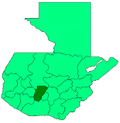Patzún
Appearance
Patzún | |
|---|---|
Municipality | |
 Central Plaza and town hall | |
| Coordinates: 14°41′N 91°01′W / 14.683°N 91.017°W | |
| Country | |
| Department | |
| Government | |
| • Major (2016-2020) | Reyes Patal Yos[1] |
| Area | |
| • Total | 64 sq mi (166 km2) |
| Population (2018 census)[2] | |
| • Total | 58,240 |
| • Density | 910/sq mi (350/km2) |
| Climate | Cwb |
Patzún (Spanish pronunciation: [patˈsun]) is a town, with a population of 26,632 (2018 census)[3] and a municipality in the Chimaltenango department of Guatemala.
History
[edit]Originally a Kaqchikel village founded in the 12th century, it belong to the Iximche kingdom until the latter was conquered by the Spaniards in the 1520s. From then it was under the jurisdiction of the Franciscans and remain such for the most part of the Spanish Colony.
In 1895, the town was visited by archeologist Alfred Percival Maudslay and his wife, Anne Cary Maudslay. Maudslay's wife described it in their book A glimpse at Guatemala.
Gallery
[edit]-
Local school girls in 1963
-
Catholic church in 2006
Climate
[edit]Patzún has a subtropical highland climate (Köppen: Cwb).
| Climate data for Patzún | |||||||||||||
|---|---|---|---|---|---|---|---|---|---|---|---|---|---|
| Month | Jan | Feb | Mar | Apr | May | Jun | Jul | Aug | Sep | Oct | Nov | Dec | Year |
| Mean daily maximum °C (°F) | 19.4 (66.9) |
20.3 (68.5) |
21.7 (71.1) |
22.5 (72.5) |
21.9 (71.4) |
20.4 (68.7) |
20.6 (69.1) |
21.1 (70.0) |
20.2 (68.4) |
19.9 (67.8) |
19.6 (67.3) |
19.4 (66.9) |
20.6 (69.0) |
| Daily mean °C (°F) | 13.3 (55.9) |
13.9 (57.0) |
15.2 (59.4) |
16.4 (61.5) |
16.9 (62.4) |
16.3 (61.3) |
16.2 (61.2) |
16.2 (61.2) |
15.7 (60.3) |
15.4 (59.7) |
14.1 (57.4) |
13.6 (56.5) |
15.3 (59.5) |
| Mean daily minimum °C (°F) | 7.3 (45.1) |
7.5 (45.5) |
8.7 (47.7) |
10.4 (50.7) |
12.0 (53.6) |
12.2 (54.0) |
11.8 (53.2) |
11.3 (52.3) |
11.3 (52.3) |
10.9 (51.6) |
8.7 (47.7) |
7.8 (46.0) |
10.0 (50.0) |
| Average precipitation mm (inches) | 2 (0.1) |
4 (0.2) |
6 (0.2) |
35 (1.4) |
112 (4.4) |
287 (11.3) |
204 (8.0) |
226 (8.9) |
319 (12.6) |
150 (5.9) |
35 (1.4) |
6 (0.2) |
1,386 (54.6) |
| Source: Climate-Data.org[4] | |||||||||||||
Geographic location
[edit]It is almost completely surrounded by Chimaltenango Department municipalities:
See also
[edit]References
[edit]- ^ "Alcaldes electos en el departamento de Chimaltenango". Municipalidades de Guatemala (in Spanish). Guatemala. 8 September 2015. Archived from the original on October 2, 2015. Retrieved 2 October 2015.
- ^ Citypopulation.de Population of departments and municipalities
- ^ Citypopulation.de Population of cities & towns in Guatemala
- ^ "Climate: Patzún". Climate-Data.org. Retrieved 19 September 2015.
- ^ a b SEGEPLAN (2010). "Municipios de Chimaltenango" (in Spanish). Guatemala. Archived from the original on 8 June 2015. Retrieved 8 June 2015.
Bibliography
[edit]- Juarros, Domingo (1818). Compendio de la historia de la Ciudad de Guatemala (in Spanish). Guatemala: Ignacio Beteta.
- Maudslay, Alfred Percival; Maudslay, Anne Cary (1899). A glimpse at Guatemala, and some notes on the ancient monuments of Central America (PDF). London, UK: John Murray.




